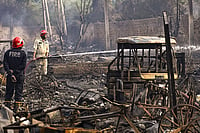Indian intelligence sources say Masood Azhar is the scion of a very rich and landed family from Bahawalpur in Pakistan's Punjab province and ever since his arrest by Indian army in the early nineties, there have been several attempts to get him released through a series of abductions. It started off with militants capturing an Indian army officer, Major Bhupinder Singh, in 1993 and asking for Azhar's release. The major was killed when the Indians refused to negotiate. The second attempt was the kidnapping of the son of Delhi-based British journalist Peter Housego, but the British intelligence prevailed in the end and Housego's son was released. The killing of the five western tourists, including American John Childs, was linked to Azhar's release and the hijacking of the Indian Airlines flight to Kandahar was the last and most effective strain in this chain of abductions.
According to security analyst Kulbir Krishan, even though these are distinct groups, there are indications that their roles are interchangeable, given the commonness of ideology, common patrons in the isi and the Afghans, and the shared cause of jehad. Sometimes even names are changed or altered to avoid detection and thus escape legal international bans. Harkat's is a case in point.
Officials in Delhi say that during Mishra's trip to the US, the Indian side brought to light a new facet to the World Trade Center strikes: the induction of western-educated and modern young men willing to undertake suicide missions, quite unlike the stereotyped bearded mullah. In this, they say groups active in Kashmir are adding a new dimension by recruiting volunteers in the UK, particularly Birmingham. The Jaish-e-Mohammed, for instance, has said that Asif Sadiq alias Mohammed Bilal, the suicide bomber who had attempted to blow up 15 Corps headquarters of the Indian army in Badamibagh, Srinagar, on Christmas eve last year, was recruited from here. Bilal was as urbane as the suicide squad that flew the planes into the World Trade Center and the Pentagon.
Clearly, India is trying its utmost to seize the opportunity provided by the US' declaration of war against terrorism to really turn the heat on the mujahideen in Kashmir. Indian foreign minister Jaswant Singh, during his trip to the US, is also expected to push India's case. The question is whether the US will be impressed by the Indian line of argument. Indian officials say the ban on Harkat-ul-Mujahideen is a good beginning. But the US action may well have been guided by its own interests rather than the situation that prevails in Kashmir.

























